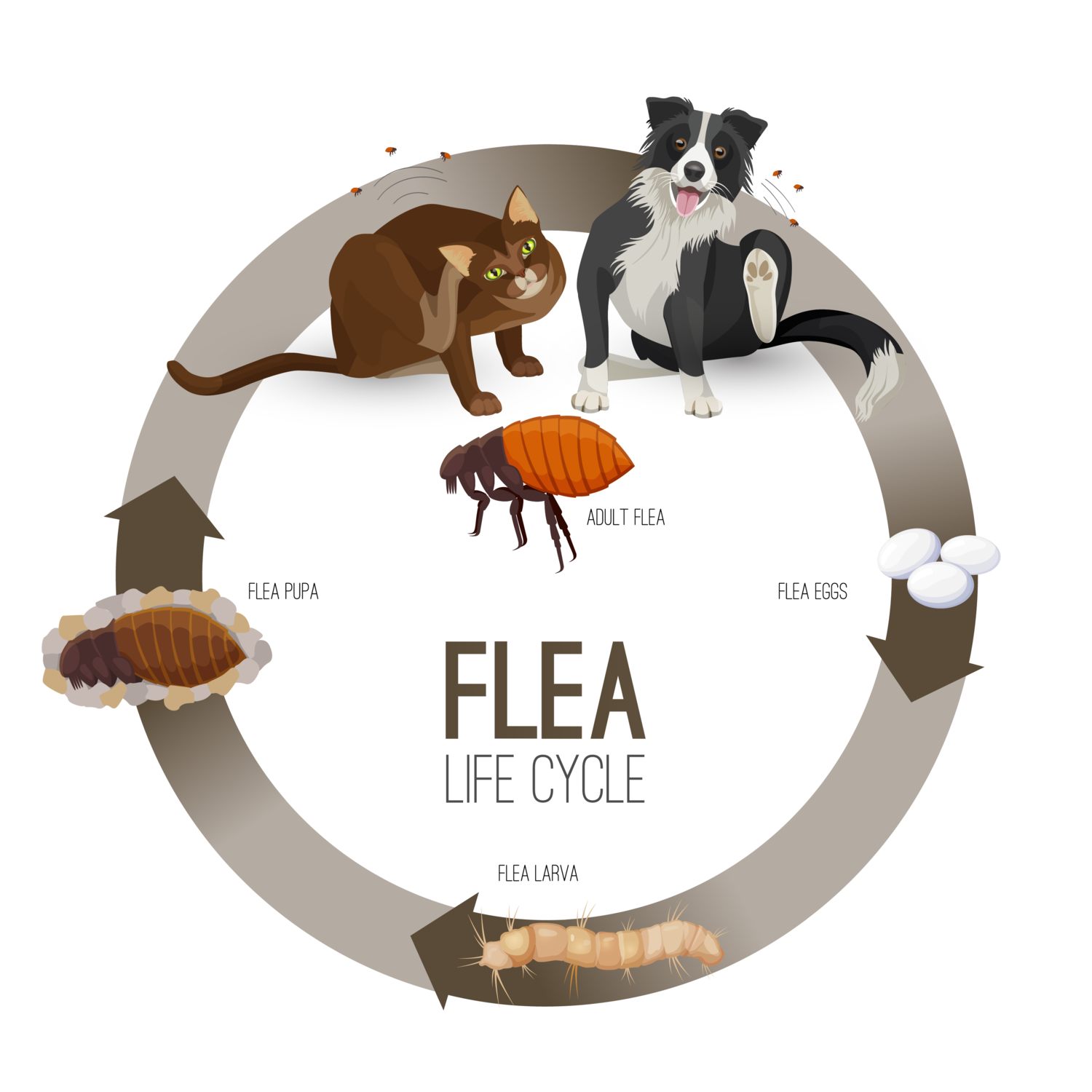How Do I Get Rid of Fleas?
Fleas are a pain! A flea is a wingless insect that can jump onto an animal and feed on the pet’s blood by biting. When fleas bite, it itches! Not to mention there are bacterial infections and tapeworms that can be transmitted by a flea bite. Pets can get fleas from being outside, going to the groomers, and even stray animals. Most pet owners aren’t aware of the four distinct stages of flea maturity and, therefore, have trouble removing fleas from their home.
Egg:
The life cycle of a flea begins when the adult female lays the eggs on the host. It is easy for fleas to jump onto animals as they can jump 6 inches vertically. These eggs are white and very tiny. They are about the size of a grain of sand (or even smaller). The eggs can fall off of animals as they move, which scatters them throughout the pet’s environment. In cold and dry environments, the eggs will take longer to hatch. In a hot and humid environment, the eggs will hatch relatively quickly.
There are sprays that treat flea eggs to prevent fleas from growing to maturity (to mate and reproduce).
Larvae:
The larvae are hatched from their eggs and survive by eating blood left by the adult flea. The larvae are about 1⁄4 inch long and are almost transparent. They do not have legs at this point. Just like the flea eggs, if the environment and conditions are just right, the larvae will spin cocoons in week to less than a month. The cocoon is spun out of fibers, hair, lint, dust and fabrics and is nearly invisible.
There are sprays that treat flea larvae to prevent fleas from growing to maturity (to mate and reproduce).
Pupae:
This can also be called the cocoon stage. The water-tight cocoon protects the pupae while it is waiting to emerge as an adult flea. There is a sticky coating on the cocoon that allows them to nestle into carpet, which makes it hard to remove with a vacuum. The movement of pets make the environment just right for the adult flea to come out of the cocoon.
If a home has been sprayed or a carpet has been treated, that is not enough to treat fleas in the cocoon stage. New fleas can emerge unharmed after the initial treatment.
Adult Flea:
Just like any other living thing, fleas need food to survive. Once the flea emerges from the cocoon, it is time to feed. Not long after feeding, the fleas will begin to mate and lay eggs. Adult fleas are flat and dark in color. As they feed on your pet’s blood, their color will become lighter and the flea will become larger. Fleas can consume 15% of their body weight daily.
Sprays or chemicals will kill adult fleas on contact but, again, will not penetrate the pupae / cocoon stage of flea development.
Fleas are very small and can sometimes be hard to see. In fact, your pet could have fleas and you may not even know. It is important to inspect for fleas, especially in the warm months.
So how do you inspect your pet for fleas? The first sign may be black specks in the pets fur. This is usually called “flea dirt” which is fecal matter from an adult flea. To check for black specks:
● Comb through your pet’s hair while making sure the comb reaches the skin. If you find black specks on the comb after combing your pet, it may be flea dirt. If you find fleas on the comb, drown the fleas in soapy water immediately.
● Place a white towel or paper towel under your pet and run your hands across your pet’s fur. If you find black specks on the towel, it may be flea dirt.
● If you are unsure if it is flea dirt, place the black specks on a wet paper towel. Later, if it turns a rusty red color, you can guarantee it is flea dirt because the reddish color is the blood that has been sucked from your pet. If the specks do not turn a reddish color on the wet paper towel, it is probably just outdoor dirt.
You also may begin noticing your pet constantly scratching and chewing themselves. Fleas can be extremely irritating to pets and the constant scratching may lead to hairless patches on your pet and red, irritated skin.
Lastly, look closely: You may see little quick moving brown spots on your pets fur - that’s a flea!
As mentioned, getting rid of fleas may prove difficult because of the four distinct stages of flea lifecycle. Removal will require treatment of the pet and the pet’s environment.
-Wash all of your pet’s bedding.
-Wash all of your pet’s toys, clothing, and anything else that your pet may have been in contact with
-Vacuum your home thoroughly; be sure to take the vacuum outside, remove the bag, and throw the bag in the trash. It can take several vacuum sessions to remove most or all of the flea eggs from the carpet.
-Keep your yard free of debris such as grass clippings and leaves piles
Products for treating dogs and cats for fleas are available in several forms available at HART:
-Seresto Flea Collar for dogs and cats that lasts about 8 months and prevents fleas and ticks
-Revolution for dogs and cats is a monthly topical solution that kills adult fleas and prevents flea eggs from hatching
- Advantage Multi for cats is a monthly topical solution that provides broad-spectrum parasite protection in a convenient monthly application that can break the flea lifecycle
- NexGard for dogs is a beef-flavored chew that kill adult fleas
-Sentinel Spectrum is a monthly oral preventive prescription that prevents the development of flea egg
In addition, there are shampoos that last days, dips that last for weeks, and oral medications that last 12 weeks. Powders used to be popular but now they are not typically used as there are more efficient options.
Talk to Dr. Jessy or Dr. Weimer about the options for your pets.
Many flea treatments also protect from ticks, parasites, and heartworms so it is sensible to contact us here at the HART Bredel Veterinary Clinic to talk about the most appropriate treatment for your furry family member.

